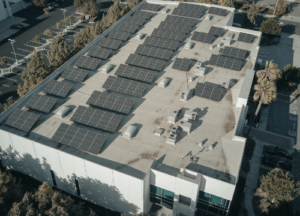Clean Energy: A Solution for Resiliency
Natural disasters can have a devastating impact on communities, causing loss of life, property damage, and negative health impacts. In the aftermath of a natural disaster, many consider what could’ve been done to prevent some of the damages, and what can be done in the future to address these issues.
The growth of clean energy has provided new solutions for resiliency, with the implementation of microgrids, solar arrays with battery backup systems and electric vehicle to grid capabilities. John Barnett, the director of the National Renewable Energy Laboratory’s (NREL) Energy Security and Resilience Center has stated, “a clean, economic, and equitable energy future is not possible without designing for security and resilience, given the range of potential disruptions from natural and human sources.”

Following the impacts of Hurricane Helene, many individuals in the clean energy industry within North Carolina have turned their attention to how renewable energy can assist in recovery efforts, and how some methods will be useful in preparation for future environmental impacts.
At Making Energy Work (MEW), a keynote with panelists Matt Abele (NC Sustainable Energy Association), Will Heegaard (Footprint Project), and Zachary Turner (WFAE Climate Reporter) shared the importance of clean energy resiliency. Abele stated “without reliable energy sources and destroyed infrastructure, resilience is low.” The panelists discussed that although solar is a valuable source of energy, without battery storage it is unable to be tapped into during disasters, as solar panels alone cannot send power to the grid. Heegard shared that communication is key during disasters, making microgrids a useful tool.
Microgrids are able to operate as a single controllable entity with distributed resources that allow a small, localized grid to island and continue running if there is an outage of the larger grid. Establishing a microgrid prior to a disaster can keep power on for critical facilities, such as emergency operations centers, hospitals, and water/wastewater infrastructure, ensuring services to communities can continue during disaster recovery. The ability to establish internet connection and power important medical devices is crucial, especially in the event of a disaster.
Following Hurricane Helene, the Footprint Project recognized the need for emergency solar and battery microgrids in Western North Carolina. They quickly deployed and mobilized local resources and donations to install 49 systems at community facilities and homes, totaling more than 100 kW of solar PV and over 250 kWH of battery storage. Heegaard noted that local solar installers can be a valuable part of an emergency response after a natural disaster if they have the correct tools and training. Installing panels in areas of need can allow quick access to energy that can power essential equipment.
Implementing clean energy solutions to protect residential areas is also an important strategy. Clean transportation infrastructure like a Tesla Powerwall can be utilized in the case of a power outage. A Powerwall is a compact battery that can be installed on the side of a home to store energy that is either generated by solar or from the grid. The system can store extra energy from a residential solar system and save it for times of need. A Powerwall has the ability to power an entire home, including heating and cooling systems. Tesla’s Storm Watch service identifies when severe weather is forecasted and automatically charges the Powerwall to its maximum capacity. Additionally, some electric vehicle (EV) models, like the Ford F150 Lightning, can be used as mobile batteries.

Tesla Powerwall, Source: Local Pro Electrical
The United States Department of Energy has also created programs to engage communities in research on how they can prepare for power disruptions caused by severe weather through investments in resilient solar and storage. The Renewables Advancing Community Energy Resilience (RACER) funding program supports 20 projects throughout the United States, one of which is led by the NC Clean Energy Technology Center (NCCETC).
Led by Isaac Panzarella, Associate Director at the NC Cleantech Center, the Resilient Renewable Energy to Diminish Disaster Impacts on Communities (Resilient REDDI Communities) project will work towards creating a guide for emergency managers within the state to implement resilient strategies that will decrease the impact of potential energy loss during a natural disaster.
Panzarella says it is necessary to “secure critical assets or facilities with resilient energy systems as part of a disaster preparedness strategy”. Facilities such as fire departments, schools, and hospitals can act as community resilience hubs in response to a disaster. By implementing technologies such as solar battery powered generators, these areas can be equipped with the proper resources to support individuals in times of severe weather or natural disasters.

As technology advances and more clean energy solutions are identified, individuals and emergency response organizations can utilize these methods to protect themselves and their houses from climate impacts – before disaster strikes.
For more information about clean energy resiliency, visit the U.S. DOE Solar Energy Technology Office’s Solar and Resilience Basics page.